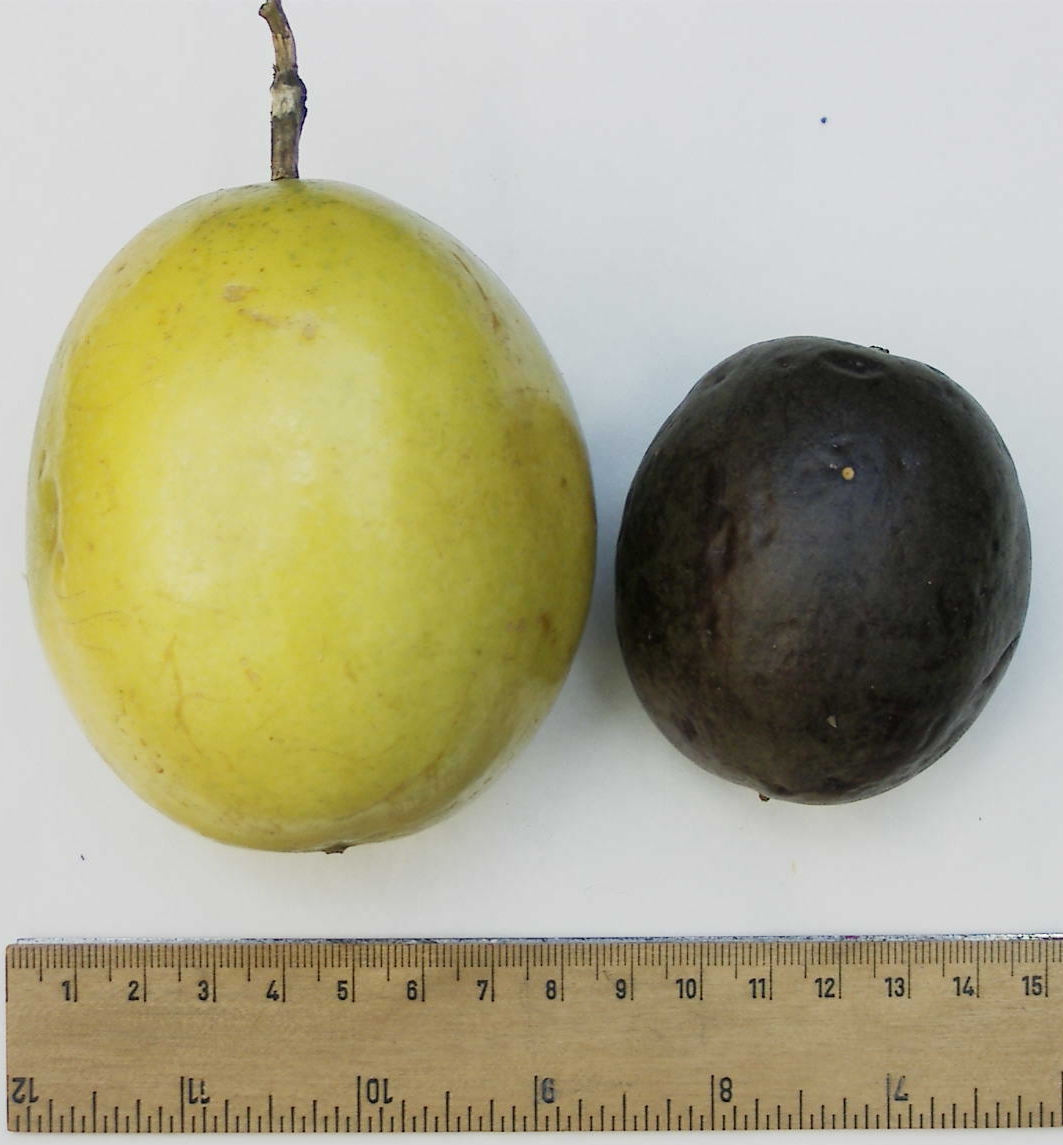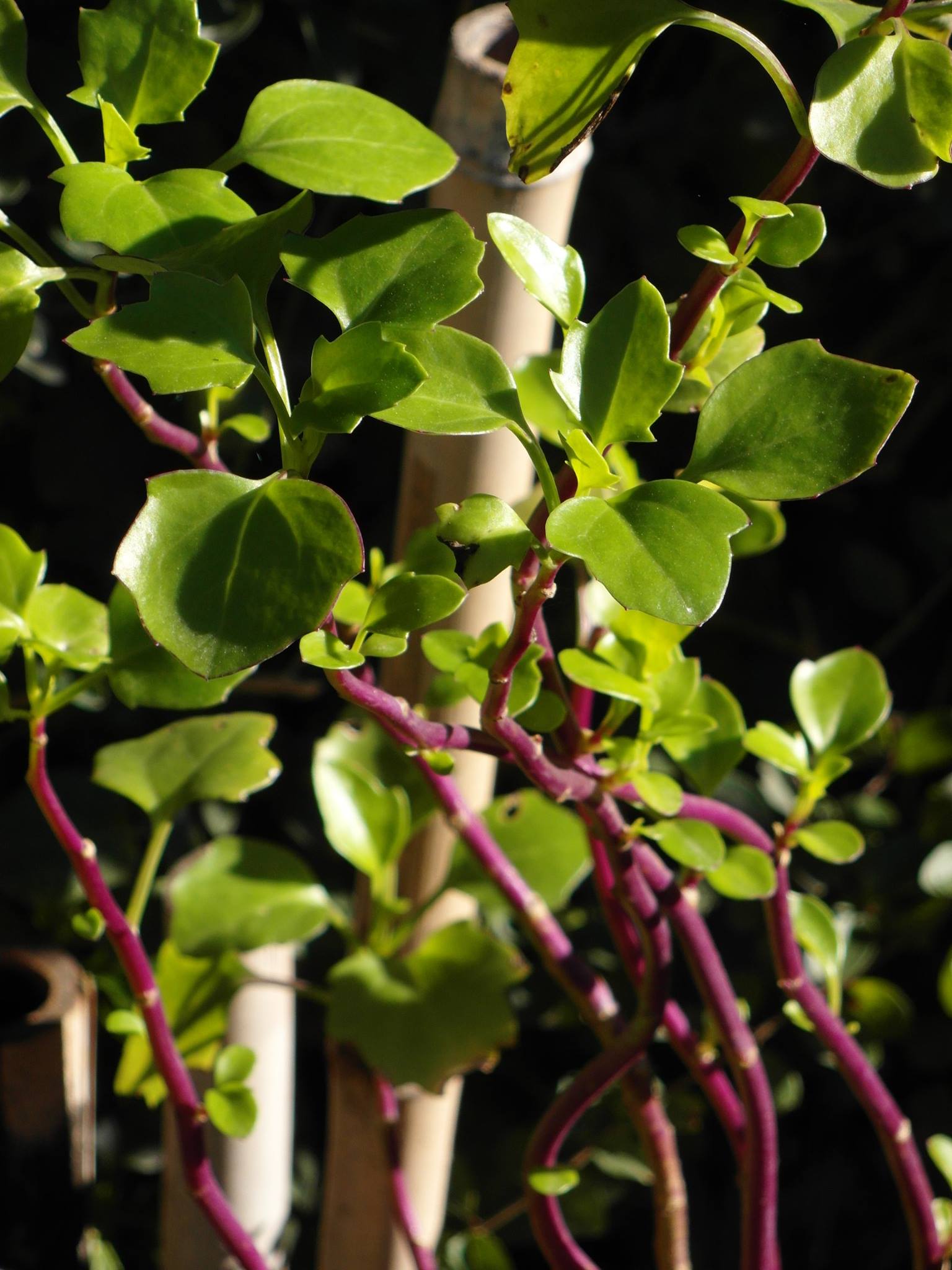|
Passionfruit
''Passiflora edulis,'' commonly known as passion fruit, is a vine species of passion flower native to southern Brazil through Paraguay and northern Argentina. It is cultivated commercially in tropical and subtropical areas for its sweet, seedy fruit. The fruit is a Pepo (botany), pepo, a type of Berry (botany), berry, round to oval, either yellow or dark purple at maturity, with a soft to firm, juicy interior filled with numerous seeds. The fruit is both eaten and juiced, the juice often added to other fruit juices to enhance aroma. Etymology The passion fruit is so called because it is one of the many species of passion flower, the English translation of the Latin genus name, ''Passiflora''. Around 1700, the name was given by Spanish missions in South America, missionaries in Brazil as an educational aid while trying to convert the indigenous inhabitants to Christianity; its name was ''flor das cinco chagas'' or "flower of the Five Holy Wounds, five wounds" to illustrate the cru ... [...More Info...] [...Related Items...] OR: [Wikipedia] [Google] [Baidu] |
Passion Flower
''Passiflora'', known also as the passion flowers or passion vines, is a genus of about 550 species of flowering plants, the type genus of the family Passifloraceae. They are mostly tendril-bearing vines, with some being shrubs or trees. They can be woody or herbaceous. Passion flowers produce regular and usually showy flowers with a distinctive corona. There can be as many as eight coronal series, as in the case of ''P. xiikzodz''. The flower is pentamerous and ripens into an indehiscent fruit with numerous seeds. List of species Distribution ''Passiflora'' has a largely neotropic distribution, unlike other genera in the family Passifloraceae, which includes more Old World species (such as the genus ''Adenia''). The vast majority of ''Passiflora'' are found in Mexico, Central America, the United States and South America, although there are additional representatives in Southeast Asia and Oceania. New species continue to be identified: for example, '' P. xishuangbannaensi ... [...More Info...] [...Related Items...] OR: [Wikipedia] [Google] [Baidu] |
Brazil
Brazil ( pt, Brasil; ), officially the Federative Republic of Brazil (Portuguese: ), is the largest country in both South America and Latin America. At and with over 217 million people, Brazil is the world's fifth-largest country by area and the seventh most populous. Its capital is Brasília, and its most populous city is São Paulo. The federation is composed of the union of the 26 states and the Federal District. It is the largest country to have Portuguese as an official language and the only one in the Americas; one of the most multicultural and ethnically diverse nations, due to over a century of mass immigration from around the world; and the most populous Roman Catholic-majority country. Bounded by the Atlantic Ocean on the east, Brazil has a coastline of . It borders all other countries and territories in South America except Ecuador and Chile and covers roughly half of the continent's land area. Its Amazon basin includes a vast tropical forest, ho ... [...More Info...] [...Related Items...] OR: [Wikipedia] [Google] [Baidu] |
John Sims (taxonomist)
John Sims (13 October 1749 – 26 February 1831) was an English physician and botanist. He was born in Canterbury, Kent and was subsequently educated at the Quaker school in Burford, Oxfordshire, he then went on to study medicine at Edinburgh University. Later in life he moved to London (1766) where he worked as a physician, notably he was involved with the birth of Princess Charlotte in which both mother and baby died. He was the first editor of Curtis's Botanical Magazine. Early life Sims was born in Canterbury, Kent, the son of, Robert Courthope Sims (1720–1812), a physician, and Rebecca née Tritton (1723–c1781). His father was a member of the Society of Friends who published ''An Essay on the Nature and Constitution of Man'' . He was educated at the Quaker school in Burford, Oxfordshire, with additional instruction from his father. He studied medicine at Edinburgh University, obtaining his PhD in 1774. His dissertation was "De usu aquæ frigidæ interno." Career M ... [...More Info...] [...Related Items...] OR: [Wikipedia] [Google] [Baidu] |
Node (plant)
A stem is one of two main structural axes of a vascular plant, the other being the root. It supports leaves, flowers and fruits, transports water and dissolved substances between the roots and the shoots in the xylem and phloem, stores nutrients, and produces new living tissue. The stem can also be called halm or haulm. The stem is normally divided into nodes and internodes: * The nodes hold one or more leaves, as well as buds which can grow into branches (with leaves, conifer cones, or flowers). Adventitious roots may also be produced from the nodes. * The internodes distance one node from another. The term "shoots" is often confused with "stems"; "shoots" generally refers to new fresh plant growth including both stems and other structures like leaves or flowers. In most plants stems are located above the soil surface but some plants have underground stems. Stems have four main functions which are: * Support for and the elevation of leaves, flowers, and fruits. The stems ... [...More Info...] [...Related Items...] OR: [Wikipedia] [Google] [Baidu] |
Grapefruit
The grapefruit (''Citrus'' × ''paradisi'') is a subtropical citrus tree known for its relatively large, sour to semi-sweet, somewhat bitter fruit. The interior flesh is segmented and varies in color from pale yellow to dark pink. Grapefruit is a citrus hybrid originating in Barbados. It is an accidental cross between the sweet orange (''C. sinensis'') and the pomelo or shaddock (''C. maxima''), both of which were introduced from Asia in the 17th century. It has also been called the '' forbidden fruit''. In the past it was referred to as the ''pomelo'', but that term is now mostly used as the common name for ''Citrus maxima''. In 2019, world production of grapefruits (combined with pomelos) was 9.3 million tonnes, of which 53% was in China. Other significant producers include Vietnam, United States and Mexico. Description The evergreen grapefruit trees usually grow to around tall, although they may reach . The leaves are long (up to ), thin, glossy, and dark green. They p ... [...More Info...] [...Related Items...] OR: [Wikipedia] [Google] [Baidu] |
Guava
Guava () is a common tropical fruit cultivated in many tropical and subtropical regions. The common guava '' Psidium guajava'' (lemon guava, apple guava) is a small tree in the myrtle family (Myrtaceae), native to Mexico, Central America, the Caribbean and northern South America. The name guava is also given to some other species in the genus '' Psidium'' such as strawberry guava (''Psidium cattleyanum'') and to the pineapple guava, ''Feijoa sellowiana''. In 2019, 55 million tonnes of guavas were produced worldwide, led by India with 45% of the total. Botanically, guavas are berries. Types The most frequently eaten species, and the one often simply referred to as "the guava", is the apple guava (''Psidium guayava''). Guavas are typical Myrtoideae, with tough dark heavy leaves that are opposite, simple, elliptic to ovate, and long. The flowers are white, with five petals and numerous stamens. The fruits are many-seeded berries. Etymology The term ''guava'' app ... [...More Info...] [...Related Items...] OR: [Wikipedia] [Google] [Baidu] |
Pith
Pith, or medulla, is a tissue in the stems of vascular plants. Pith is composed of soft, spongy parenchyma cells, which in some cases can store starch. In eudicotyledons, pith is located in the center of the stem. In monocotyledons, it extends also into flowering stems and roots. The pith is encircled by a ring of xylem; the xylem, in turn, is encircled by a ring of phloem. While new pith growth is usually white or pale in color, as the tissue ages it commonly darkens to a deeper brown color. In trees pith is generally present in young growth, but in the trunk and older branches the pith often gets replaced – in great part – by xylem. In some plants, the pith in the middle of the stem may dry out and disintegrate, resulting in a hollow stem. A few plants, such as walnuts, have distinctive chambered pith with numerous short cavities (See image at middle right). The cells in the peripheral parts of the pith may, in some plants, develop to be different from cells in the ... [...More Info...] [...Related Items...] OR: [Wikipedia] [Google] [Baidu] |
Berry (botany)
In botany, a berry is a fleshy fruit without a stone (pit) produced from a single flower containing one ovary. Berries so defined include grapes, currants, and tomatoes, as well as cucumbers, eggplants (aubergines) and bananas, but exclude certain fruits that meet the culinary definition of berries, such as strawberries and raspberries. The berry is the most common type of fleshy fruit in which the entire outer layer of the ovary wall ripens into a potentially edible " pericarp". Berries may be formed from one or more carpels from the same flower (i.e. from a simple or a compound ovary). The seeds are usually embedded in the fleshy interior of the ovary, but there are some non-fleshy exceptions, such as peppers, with air rather than pulp around their seeds. Many berries are edible, but others, such as the fruits of the potato and the deadly nightshade, are poisonous to humans. A plant that bears berries is said to be bacciferous or baccate (a fruit that resembles a ... [...More Info...] [...Related Items...] OR: [Wikipedia] [Google] [Baidu] |
Stigma (botany)
The stigma () is the receptive tip of a carpel, or of several fused carpels, in the gynoecium of a flower. Description The stigma, together with the style and ovary (typically called the stigma-style-ovary system) comprises the pistil, which is part of the gynoecium or female reproductive organ of a plant. The stigma itself forms the distal portion of the style, or stylodia, and is composed of , the cells of which are receptive to pollen. These may be restricted to the apex of the style or, especially in wind pollinated species, cover a wide surface. The stigma receives pollen and it is on the stigma that the pollen grain germinates. Often sticky, the stigma is adapted in various ways to catch and trap pollen with various hairs, flaps, or sculpturings. The pollen may be captured from the air (wind-borne pollen, anemophily), from visiting insects or other animals (biotic pollination), or in rare cases from surrounding water ( hydrophily). Stigma can vary from long and sle ... [...More Info...] [...Related Items...] OR: [Wikipedia] [Google] [Baidu] |
Style (botany)
The stigma () is the receptive tip of a carpel, or of several fused carpels, in the gynoecium of a flower. Description The stigma, together with the style and ovary (typically called the stigma-style-ovary system) comprises the pistil, which is part of the gynoecium or female reproductive organ of a plant. The stigma itself forms the distal portion of the style, or stylodia, and is composed of , the cells of which are receptive to pollen. These may be restricted to the apex of the style or, especially in wind pollinated species, cover a wide surface. The stigma receives pollen and it is on the stigma that the pollen grain germinates. Often sticky, the stigma is adapted in various ways to catch and trap pollen with various hairs, flaps, or sculpturings. The pollen may be captured from the air (wind-borne pollen, anemophily), from visiting insects or other animals (biotic pollination), or in rare cases from surrounding water ( hydrophily). Stigma can vary from long and slende ... [...More Info...] [...Related Items...] OR: [Wikipedia] [Google] [Baidu] |

.jpg)



